Children’s Participation in the Design of Smart Solutions: A Literature Review †
Abstract
:1. Introduction
- to understand the current situation related to the design of smart solutions by children and provide an overview of how such workshops take place;
- to articulate reflections on future directions based on this overview.
2. Materials and Methods
2.1. Research Questions
- RQ1
- What is the current situation related to the design of smart solutions by children?
- RQ2
- What should be considered in future design workshops of smart solutions by children?
2.2. Data Collection
2.3. Inclusion Criteria
3. Results
3.1. Smart City Design by Children
3.1.1. Roobopoli Workshops
Design Stages & Materials
Setting & Participants
3.2. Smart Object Design by Children
3.2.1. SNaP Workshops
Design Stages & Materials
Setting & Participants
4. Overview of Workshops
4.1. Overview of Smart City Design by Children
4.2. Overview of Smart Object Design by Children
5. Discussion
5.1. Design Stages
5.2. Materials
5.3. Settings and Modalities
5.4. Participants
6. Conclusions
Author Contributions
Funding
Institutional Review Board Statement
Informed Consent Statement
Conflicts of Interest
References
- Giffinger, R.; Fertner, C.; Kramar, H.; Meijers, E. City-ranking of European medium-sized cities. Cent. Reg. Sci. 2007, 9, 1–12. [Google Scholar]
- Clarinval, A.; Deremiens, C.; Dardenne, T.; Dumas, B. Introducing the Smart City to Children with a Tangible Interaction Table. In Proceedings of the 32e Conférence Francophone sur l’Interaction Homme-Machine, Virtual Event, 13–16 April 2021. [Google Scholar]
- Batty, M.; Axhausen, K.; Giannotti, F.; Pozdnoukhov, A.; Bazzani, A.; Wachowicz, M.; Ouzounis, G.; Portugali, Y. Smart cities of the future. Eur. Phys. J. Spec. Top. 2012, 214, 481–518. [Google Scholar] [CrossRef] [Green Version]
- Kortuem, G.; Kawsar, F.; Sundramoorthy, V.; Fitton, D. Smart objects as building blocks for the Internet of things. IEEE Internet Comput. 2010, 14, 44–51. [Google Scholar] [CrossRef] [Green Version]
- Zulkarnaen, R.; Setiawan, W.; Rusdiana, D.; Muslim, M. Smart city design in learning science to grow 21st century skills of elementary school student. J. Phys. Conf. Ser. 2019, 1157, 022021. [Google Scholar] [CrossRef]
- Cocchia, A. Smart and digital city: A systematic literature review. In Smart City; Springer: Berlin/Heidelberg, Germany, 2014; pp. 13–43. [Google Scholar]
- Sunyaev, A. The Internet of Things. In Internet Computing: Principles of Distributed Systems and Emerging Internet-Based Technologies; Springer: Berlin/Heidelberg, Germany, 2020; pp. 301–337. [Google Scholar]
- Simonofski, A.; Dumas, B.; Clarinval, A. Engaging children in the smart city: A participatory design workshop. In Proceedings of the 1st ACM SIGSOFT International Workshop on Education through Advanced Software Engineering and Artificial Intelligence, Tallinn, Estonia, 26–27 August 2019; pp. 1–4. [Google Scholar]
- Hollands, R.G. Will the real smart city please stand up?: Intelligent, progressive or entrepreneurial? In The Routledge Companion to Smart Cities; Routledge: London, UK, 2020; pp. 179–199. [Google Scholar]
- Wanderley, A.R.M.C.; Bonacin, R. Designing mobile and iot solutions for sustainable smart cities: Studies with electronic waste disposal. In Proceedings of the International Conference on Human-Computer Interaction, Orlando, FL, USA, 26–31 July 2019; pp. 212–226. [Google Scholar] [CrossRef]
- Gianni, F.; Divitini, M. Designing IoT Applications for Smart Cities: Extending the Tiles Ideation Toolkit. IxD&A 2017, 35, 100–116. [Google Scholar]
- Wolff, A.; Barker, M.; Hudson, L.; Seffah, A. Supporting smart citizens: Design templates for co-designing data-intensive technologies. Cities 2020, 101, 102695. [Google Scholar] [CrossRef]
- Peacock, S.; Harlow, J.; Gordon, E. Beta Blocks: Inviting Playful Community Exploration of Smart City Technologies in Boston, USA. In Making Smart Cities More Playable: Exploring Playable Cities; Springer: Singapore, 2020; pp. 131–147. [Google Scholar] [CrossRef]
- Goodman, N.; Zwick, A.; Spicer, Z.; Carlsen, N. Public engagement in smart city development: Lessons from communities in Canada’s Smart City Challenge. Can. Geogr. Gé/Ographe Can. 2020, 64, 416–432. [Google Scholar] [CrossRef]
- Wolff, A.; Juarez, A.V.; Barker, M.; Potter, S.; Gooch, D.; Giles, E.; Miles, J. Engaging with the Smart City through Urban Data Games. In Playable Cities: The City as a Digital Playground; Nijholt, A., Ed.; Number 1 in Gaming Media and Social Effects; Springer: Berlin/Heidelberg, Germany, 2017; pp. 47–66. [Google Scholar] [CrossRef] [Green Version]
- Díaz, J.; Ancán, O.; Ancán, O. An Agile Product Design in a Smart City Context: A Use Case for Air Pollution Awareness. In Social Computing and Social Media. Participation, User Experience, Consumer Experience, and Applications of Social Computing; Meiselwitz, G., Ed.; Springer International Publishing: Cham, Switzerland, 2020; pp. 483–500. [Google Scholar]
- Kbar, G.; Mian, S.H.; Abidi, M.H. Unified Interface for People with Disabilities (UI-PWD) at Smart City (Design and Implementation). In Information Innovation Technology in Smart Cities; Springer: Singapore, 2018; pp. 3–20. [Google Scholar] [CrossRef]
- Simonofski, A.; Asensio, E.S.; De Smedt, J.; Snoeck, M. Citizen Participation in Smart Cities: Evaluation Framework Proposal. In Proceedings of the 2017 IEEE 19th Conference on Business Informatics (CBI), Thessaloniki, Greece, 24–27 July 2017; Volume 1, pp. 227–236. [Google Scholar] [CrossRef]
- Dowse, S.; Powell, S.; Weed, M. Mega-sporting events and children’s rights and interests—Towards a better future. Leis. Stud. 2018, 37, 97–108. [Google Scholar] [CrossRef]
- Hennig, S. Smart Cities Need Smart Citizens, but What about Smart Children? In REAL CORP 2014–PLAN IT SMART! Clever Solutions for Smart Cities, Proceedings of 19th International Conference on Urban Planning, Regional Development and Information Society, Vienna, Austria, 20–23 May 2014; CORP–Competence Center of Urban and Regional Planning: Vienna, Austria, 2014; pp. 553–561. [Google Scholar]
- Gomes, C.A.; Gomes, H.; Rego, B.; Sousa, B.; Loureiro, M.; Rocha, P. Smart City Kids Lab: Creative Computing in Primary School. In Proceedings of the 2019 International Symposium on Computers in Education (SIIE), Tomar, Portugal, 21–23 November 2019; pp. 1–6. [Google Scholar]
- Chawla, L. Evaluating children’s participation: Seeking areas of consensus. PLA Notes 2001, 42, 13. [Google Scholar]
- Kinnula, M.; Iivari, N. Empowered to Make a Change: Guidelines for Empowering the Young Generation in and through Digital Technology Design. In Proceedings of the FabLearn Europe 2019 Conference (FabLearn Europe’19), Oulu, Finland, 28–29 May 2019; Association for Computing Machinery: New York, NY, USA, 2019. [Google Scholar] [CrossRef]
- Iversen, O.S.; Smith, R.C.; Dindler, C. Child as Protagonist: Expanding the Role of Children in Participatory Design. In Proceedings of the 2017 Conference on Interaction Design and Children (IDC’17), Stanford, CA, USA, 27–30 June 2017; Association for Computing Machinery: New York, NY, USA, 2017; pp. 27–37. [Google Scholar] [CrossRef] [Green Version]
- Iivari, N.; Kinnula, M. Empowering Children through Design and Making: Towards Protagonist Role Adoption. In Proceedings of the 15th Participatory Design Conference: Full Papers—Volume 1 (PDC’18), Hasselt and Genk, Belgium, 20–24 August 2018; Association for Computing Machinery: New York, NY, USA, 2018. [Google Scholar] [CrossRef]
- Dean, P.G. Mindstorms: Children, computers and powerful ideas, by Seymour Papert. Pp 230.£ 9· 95. 1980. ISBN 0-85527-163-9 (Harvester Press). Math. Gaz. 1981, 65, 298–299. [Google Scholar] [CrossRef]
- Bakala, E.; Gerosa, A.; Hourcade, J.P.; Tejera, G. Preschool children, robots, and computational thinking: A systematic review. Int. J. Child-Comput. Interact. 2021, 29, 100337. [Google Scholar] [CrossRef]
- Bonani, A.; Bollin, A.; Gennari, R. Touch, See and Talk: Tangibles for Engaging Learners into Graph Algorithmic Thinking. In Proceedings of the Human-Computer Interaction—INTERACT 2021, Bari, Italy, 30 August–3 September 2021; Ardito, C., Lanzilotti, R., Malizia, A., Petrie, H., Piccinno, A., Desolda, G., Inkpen, K., Eds.; Springer International Publishing: Cham, Switzerland, 2021; pp. 630–651. [Google Scholar]
- Hsu, Y.C.; Baldwin, S.; Ching, Y.H. Learning through Making and Maker Education. TechTrends 2017, 61, 589–594. [Google Scholar] [CrossRef]
- Thoring, K.; Müller, R.M. Understanding the creative mechanisms of design thinking: An evolutionary approach. In Proceedings of the Second Conference on Creativity and Innovation in Design, Eindhoven, The Netherlands, 19–21 October 2011; pp. 137–147. [Google Scholar] [CrossRef]
- Pellegrino, M.A.; Roumelioti, E.; Gennari, R.; D’Angelo, M. Smart City Design as a 21st Century Skill. In Proceedings of the Methodologies and Intelligent Systems for Technology Enhanced Learning, 11th International Conference, MIS4TEL, Salamanca, Spain, 6–8 October 2021; Lecture Notes in Networks and Systems. Springer: Berlin/Heidelberg, Germany, 2021; Volume 326, pp. 271–280. [Google Scholar] [CrossRef]
- Cronin, P.; Ryan, F.; Coughlan, M. Undertaking a literature review: A step-by-step approach. Br. J. Nurs. 2008, 17, 38–43. [Google Scholar] [CrossRef] [PubMed]
- Seraphin, H.; Green, S. The significance of the contribution of children to conceptualising the destination of the future. Int. J. Tour. Cities 2019, 5, 544–559. [Google Scholar] [CrossRef]
- Stefanidi, E.; Arampatzis, D.; Leonidis, A.; Korozi, M.; Antona, M.; Papagiannakis, G. MagiPlay: An Augmented Reality Serious Game Allowing Children to Program Intelligent Environments. In Transactions on Computational Science XXXVII: Special Issue on Computer Graphics; Springer: Berlin/Heidelberg, Germany, 2020; pp. 144–169. [Google Scholar] [CrossRef]
- Stein, G.; Jean, D.; Lédeczi, A. Enabling Collaborative Distance Robotics Education for Novice Programmers. In Proceedings of the IEEE Symposium on Visual Languages and Human-Centric Computing (VL/HCC), St Louis, MO, USA, 10–13 October 2021; pp. 1–5. [Google Scholar]
- Prayaga, L.; Prayaga, C.; Wade, A.; Hart, A. A Smart Farm—An Introduction to IoT for Generation Z. In Proceedings of the International Conference on Computer Networks, Big Data and IoT, Madurai, India, 19–20 December 2019; pp. 145–152. [Google Scholar]
- D’Angelo, M.; Pellegrino, M.A. Roobopoli: A Project to Learn Robotics by a Constructionism-Based Approach. In Proceedings of the Methodologies and Intelligent Systems for Technology Enhanced Learning (TEL4FC), L’Aquila, Italy, 13–15 July 2021; pp. 249–257. [Google Scholar]
- Bekker, T.; Bakker, S.; Douma, I.; van der Poel, J.; Scheltenaar, K. Teaching children digital literacy through design-based learning with digital toolkits in schools. Int. J. Child-Comput. Interact. 2015, 5, 29–38. [Google Scholar] [CrossRef]
- Smith, R.C.; Iversen, O.S.; Hjorth, M. Design Thinking for Digital Fabrication in Education. Int. J. Child-Comput. Interact. 2015, 5, 20–28. [Google Scholar] [CrossRef]
- Frauenberger, C.; Makhaeva, J.; Spiel, K. Designing Smart Objects with Autistic Children: Four Design Exposès. In Proceedings of the 2016 CHI Conference on Human Factors in Computing Systems (CHI’16), San Jose, CA, USA, 7–12 May 2016; ACM: New York, NY, USA, 2016; pp. 130–139. [Google Scholar] [CrossRef]
- Frauenberger, C.; Makhaeva, J.; Spiel, K. Blending Methods: Developing Participatory Design Sessions for Autistic Children. In Proceedings of the 2017 Conference on Interaction Design and Children (IDC’17), Stanford, CA, USA, 27–30 June 2017; Association for Computing Machinery: New York, NY, USA, 2017; pp. 39–49. [Google Scholar] [CrossRef]
- Yavuz, S.U.; Bonetti, R.; Cohen, N. Designing the “Next” Smart Objects Together with Children. Des. J. 2017, 20, S3789–S3800. [Google Scholar] [CrossRef] [Green Version]
- Seraj, M.; Katterfeldt, E.S.; Autexier, S.; Drechsler, R. Impacts of Creating Smart Everyday Objects on Young Female Students’ Programming Skills and Attitudes. In Proceedings of the 51st ACM Technical Symposium on Computer Science Education (SIGCSE’20), Portland, OR, USA, 11–14 March 2020; Association for Computing Machinery: New York, NY, USA, 2020; pp. 1234–1240. [Google Scholar] [CrossRef] [Green Version]
- Kewalramani, S.; Palaiologou, I.; Dardanou, M. Children’s engineering design thinking processes: The magic of the ROBOTS and the power of BLOCKS (electronics). Eurasia J. Math. Sci. Technol. Educ. 2020, 16, 14. [Google Scholar] [CrossRef] [Green Version]
- Gianni, F.; Mora, S.; Divitini, M. Rapid Prototyping Internet of Things Applications for Augmented Objects: The Tiles Toolkit Approach. In Proceedings of the Ambient Intelligence, Larnaca, Cyprus, 12–14 November 2018; Kameas, A., Stathis, K., Eds.; Springer International Publishing: Cham, Switzerland, 2018; pp. 204–220. [Google Scholar]
- Mavroudi, A.; Divitini, M.; Gianni, F.; Mora, S.; Kvittem, D.R. Designing IoT applications in lower secondary schools. In Proceedings of the 2018 IEEE Global Engineering Education Conference (EDUCON), Canary Islands, Spain, 17–20 April 2018; pp. 1120–1126. [Google Scholar] [CrossRef] [Green Version]
- Gennari, R.; Melonio, A.; Rizvi, M.; Bonani, A. Design of IoT Tangibles for Primary Schools: A Case Study. In Proceedings of the 12th Biannual Conference on Italian SIGCHI Chapter (CHItaly’17), Cagliari, Italy, 18–20 September 2017; ACM: New York, NY, USA, 2017; pp. 26:1–26:6. [Google Scholar] [CrossRef]
- Gennari, R.; Matera, M.; Melonio, A.; Rizvi, M.; Roumelioti, E. Reflection and Awareness in the Design Process Children Ideating, Programming and Prototyping Smart Objects. Multimed. Tools Appl. 2020, 80, 34909–34932. [Google Scholar] [CrossRef]
- Melonio, A.; Rizvi, M.; Roumelioti, E.; De Angeli, A.; Gennari, R.; Matera, M. Children’s Beliefs and Understanding of Smart Objects: An Exploratory Study. In Proceedings of the 2020 International Conference on Advanced Visual Interfaces, AVI ’20, Salerno, Italy, 28 September–2 October 2020; Association for Computing Machinery: New York, NY, USA, 2020; pp. 1–8. [Google Scholar] [CrossRef]
- Gennari, R.; Matera, M.; Melonio, A.; Rizvi, M.; Roumelioti, E. Engaging Pre-teens in Ideating and Programming Smart Objects Through Play. In Proceedings of the Methodologies and Intelligent Systems for Technology Enhanced Learning, 10th International Conference, L’Aquila, Italy, 17–19 June 2020; Springer International Publishing: Cham, Switzerlands, 2020; pp. 31–40. [Google Scholar]
- Roumelioti, E.; Gennari, R.; Matera, M.; Melonio, A.; Rizvi, M. Towards Making Children Independent in Design. In Proceedings of the Companion Publication of the 2020 ACM Designing Interactive Systems Conference (DIS’ 20 Companion), Eindhoven, The Netherlands, 6–10 July 2020; Association for Computing Machinery: New York, NY, USA, 2020; pp. 227–232. [Google Scholar] [CrossRef]
- Roumelioti, E.; Pellegrino, M.A.; Gennari, R.; D’Angelo, M. What Children Learn in Smart-Thing Design at a Distance: An Exploratory Investigation. In Proceedings of the Methodologies and Intelligent Systems for Technology Enhanced Learning, 11th International Conference, MIS4TEL, Salamanca, Spain, 6–8 October 2021; Lecture Notes in Networks and Systems. Springer: Berlin/Heidelberg, Germany, 2021; Volume 326, pp. 22–31. [Google Scholar] [CrossRef]
- Pellegrino, M.; Roumelioti, E.; D’Angelo, M.; Gennari, R. Engaging Children in Remotely Ideating and Programming Smart Things. In Proceedings of the 14th Biannual Conference of the Italian SIGCHI Chapter (CHItaly), Bolzano, Italy, 11–13 July 2021. [Google Scholar]
- Gennari, R.; Melonio, A.; Rizvi, M. Evolving Tangibles for Children’s Social Learning through Conversations: Beyond TurnTalk. In Proceedings of the ACM International Conference on Tangible, Embedded and Embodied Interaction, TEI’18, Stockholm, Sweden, 18–21 March 2018; Association for Computing Machinery: New York, NY, USA, 2018; pp. 368–375. [Google Scholar] [CrossRef]
- Arduino. 2019. Available online: https://www.arduino.cc (accessed on 6 September 2019).
- Foundation, M.E. Micro:bit Educational Foundation|Micro:bit. 2019. Available online: https://microbit.org (accessed on 6 September 2019).
- Domínguez, F.; Ochoa, X. Smart objects in education: An early survey to assess opportunities and challenges. In Proceedings of the 2017 Fourth International Conference on eDemocracy eGovernment (ICEDEG), Quito, Ecuador, 28–30 July 2017; pp. 216–220. [Google Scholar]
- Atzori, L.; Iera, A.; Morabito, G. From “Smart Objects” to “Social Objects”: The Next Evolutionary Step of the Internet of Things. Commun. Mag. IEEE 2014, 52, 97–105. [Google Scholar] [CrossRef]
- Druin, A. The role of children in the design of new technology. Behav. Inf. Technol. 2002, 21, 1–25. [Google Scholar]
- Read, J.C.; Fitton, D.; Horton, M. Giving Ideas an Equal Chance: Inclusion and Representation in Participatory Design with Children. In Proceedings of the 2014 Conference on Interaction Design and Children (IDC’14), Aarhus, Denmark, 17–20 June 2014; Association for Computing Machinery: New York, NY, USA, 2014; pp. 105–114. [Google Scholar] [CrossRef]
- Fails, J.A.; Guha, M.L.; Druin, A. Methods and Techniques for Involving Children in the Design of New Technology for Children; Now Publishers Inc.: Hanover, MA, USA, 2013. [Google Scholar]
- Kinnula, M.; Iivari, N. Manifesto for children’s genuine participation in digital technology design and making. Int. J. Child-Comput. Interact. 2021, 28, 100244. [Google Scholar] [CrossRef]
- Bdeir, A. littleBits|Electronic Building Blocks for the 21st Century. 2019. Available online: https://littlebits.com (accessed on 6 September 2019).
- Roumelioti, E. Smart Object Design by Children as Protagonists. In Proceedings of the Methodologies and Intelligent Systems for Technology Enhanced Learning, 10th International Conference, Workshops, L’Aquila, Italy, 17–19 June 2020; Springer International Publishing: Cham, Switzerland, 2020; pp. 301–304. [Google Scholar]
- Gennari, R.; Matera, M.; Melonio, A.; Rizvi, M.; Roumelioti, E. The evolution of a toolkit for smart-thing design with children through action research. Int. J. Child-Comput. Interact. 2021, 31, 100359. [Google Scholar] [CrossRef]
- Labs, S. SAM Labs. 2020. Available online: https://samlabs.com/ (accessed on 20 March 2021).
- Microsoft. Microsoft MakeCode. 2019. Available online: https://makecode.microbit.org (accessed on 6 September 2019).
- Kalelioglu, F.; Sentance, S. Teaching with physical computing in school: The case of the micro:bit. Educ. Inf. Technol. 2020, 25, 2577–2603. [Google Scholar] [CrossRef]
- Einarsson, Á.M.; Hertzum, M. How is learning scaffolded in library makerspaces? Int. J. Child-Comput. Interact. 2020, 26, 100199. [Google Scholar] [CrossRef]
- Kinnula, M.; Sánchez Milara, I.; Norouzi, B.; Sharma, S.; Iivari, N. The show must go on! Strategies for making and makerspaces during pandemic. Int. J. Child-Comput. Interact. 2021, 29, 100303. [Google Scholar] [CrossRef]
- Constantin, A.; Alexandru, C.; Korte, J.; Wilson, C.; Fails, J.A.; Sim, G.; Read, J.C.; Eriksson, E. Distributing participation in design: Addressing challenges of a global pandemic. Int. J. Child-Comput. Interact. 2021, 28, 100255. [Google Scholar] [CrossRef]
- Gennari, R.; Melonio, A.; Raccanello, D.; Brondino, M.; Dodero, G.; Pasini, M.; Torello, S. Children’s emotions and quality of products in participatory game design. Int. J. Hum.-Comput. Stud. 2017, 101, 45–61. [Google Scholar] [CrossRef]
- Bevčič, M.; Rugelj, J. Game design based learning of programming for girls. In Proceedings of the International Convention on Information, Communication and Electronic Technology, Opatija, Croatia, 28 September–2 October 2020; pp. 576–580. [Google Scholar]
- Dasgupta, N.; Stout, J.G. Girls and Women in Science, Technology, Engineering, and Mathematics: STEMing the Tide and Broadening Participation in STEM Careers. Policy Insights Behav. Brain Sci. 2014, 1, 21–29. [Google Scholar] [CrossRef] [Green Version]
- Tisza, G.; Papavlasopoulou, S.; Christidou, D.; Voulgari, I.; Iivari, N.; Giannakos, M.N.; Kinnula, M.; Markopoulos, P. The Role of Age and Gender on Implementing Informal and Non-Formal Science Learning Activities for Children. In Proceedings of the FabLearn Europe 2019 Conference (FabLearn Europe’19), Oulu, Finland, 28–29 May 2019; Association for Computing Machinery: New York, NY, USA, 2019. [Google Scholar] [CrossRef] [Green Version]
- Kjällander, S.; Åkerfeldt, A.; Mannila, L.; Parnes, P. Makerspaces across Settings: Didactic Design for Programming in Formal and Informal Teacher Education in the Nordic Countries. J. Digit. Learn. Teach. Educ. 2018, 34, 18–30. [Google Scholar] [CrossRef]
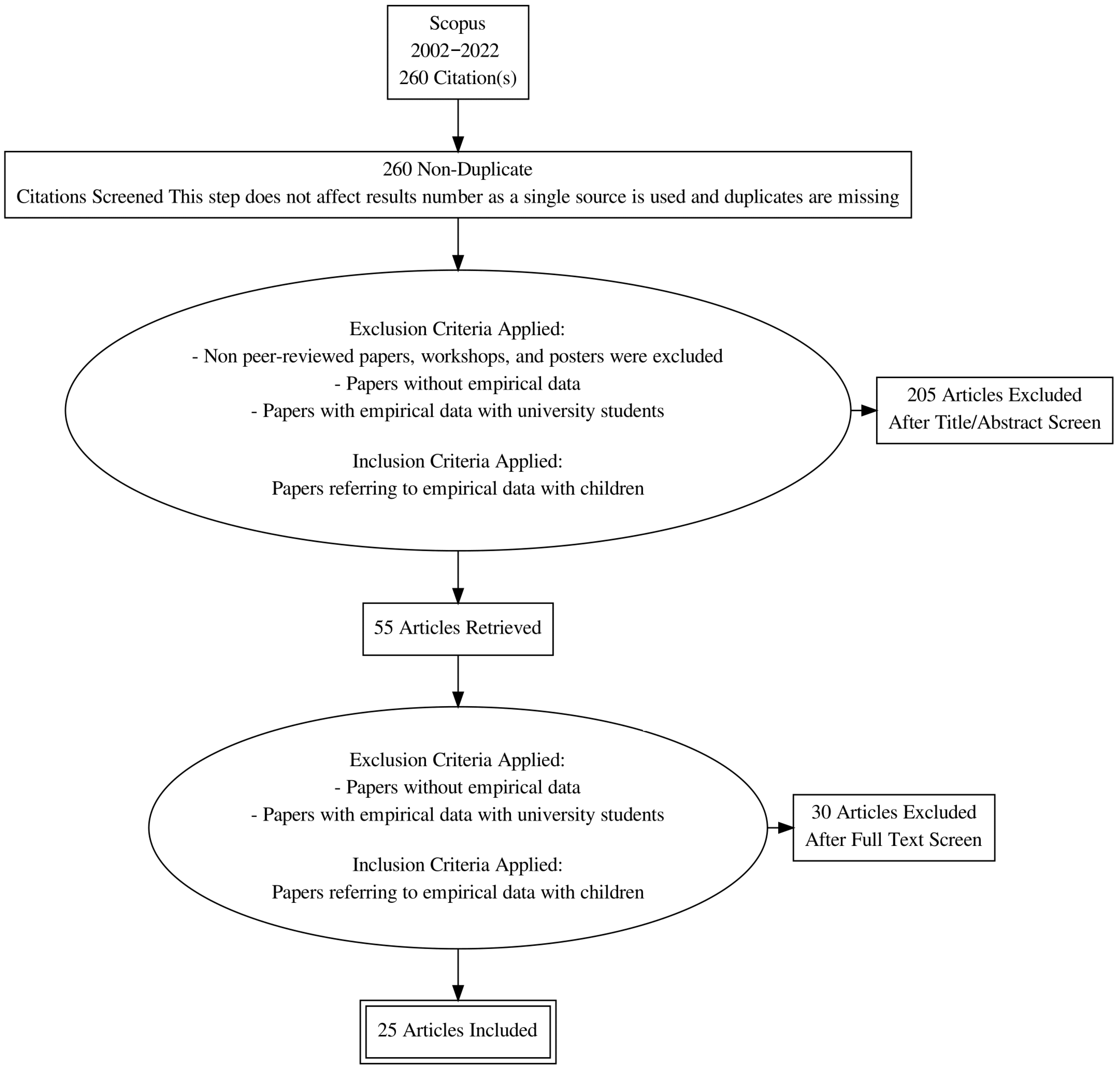
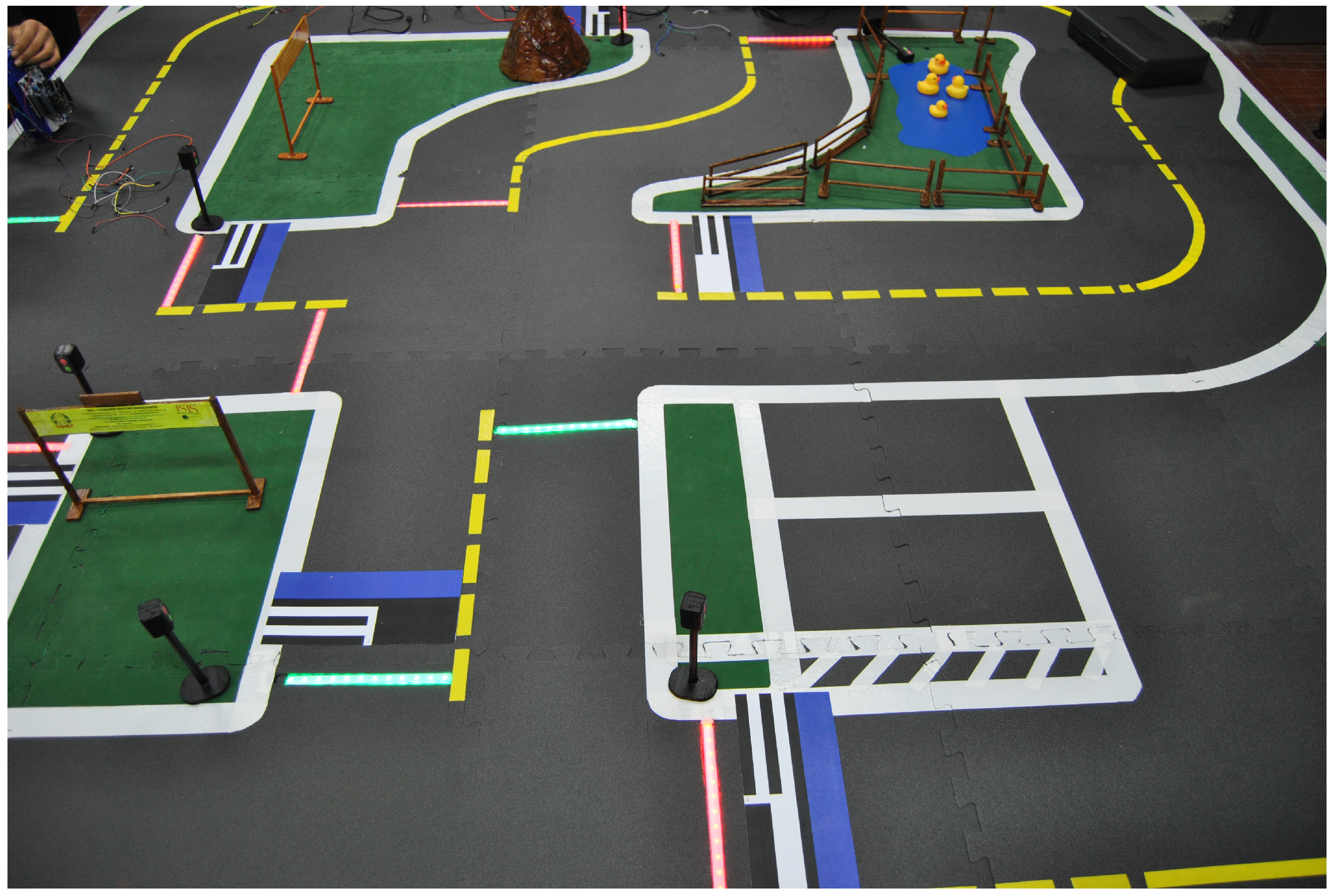
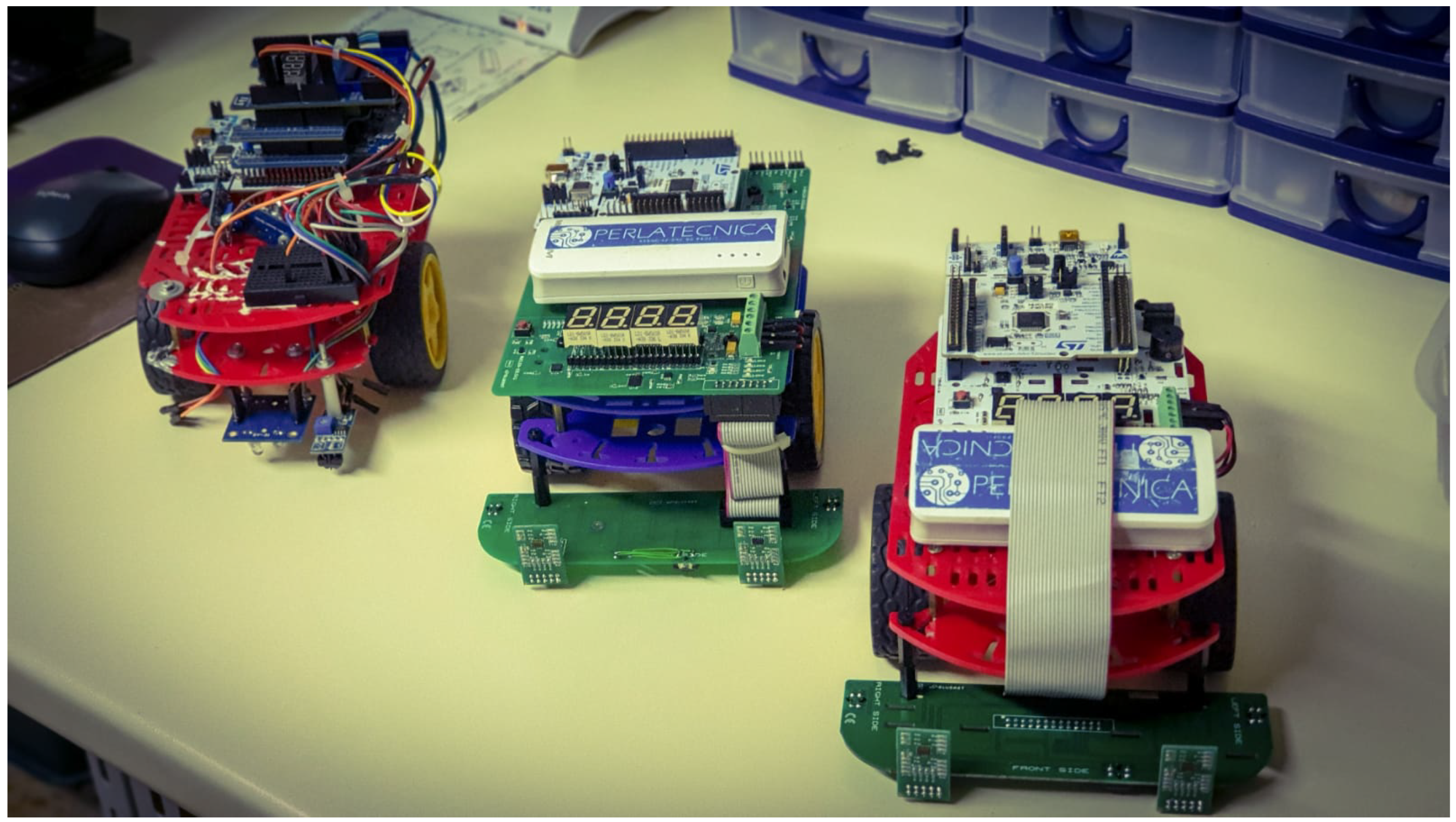
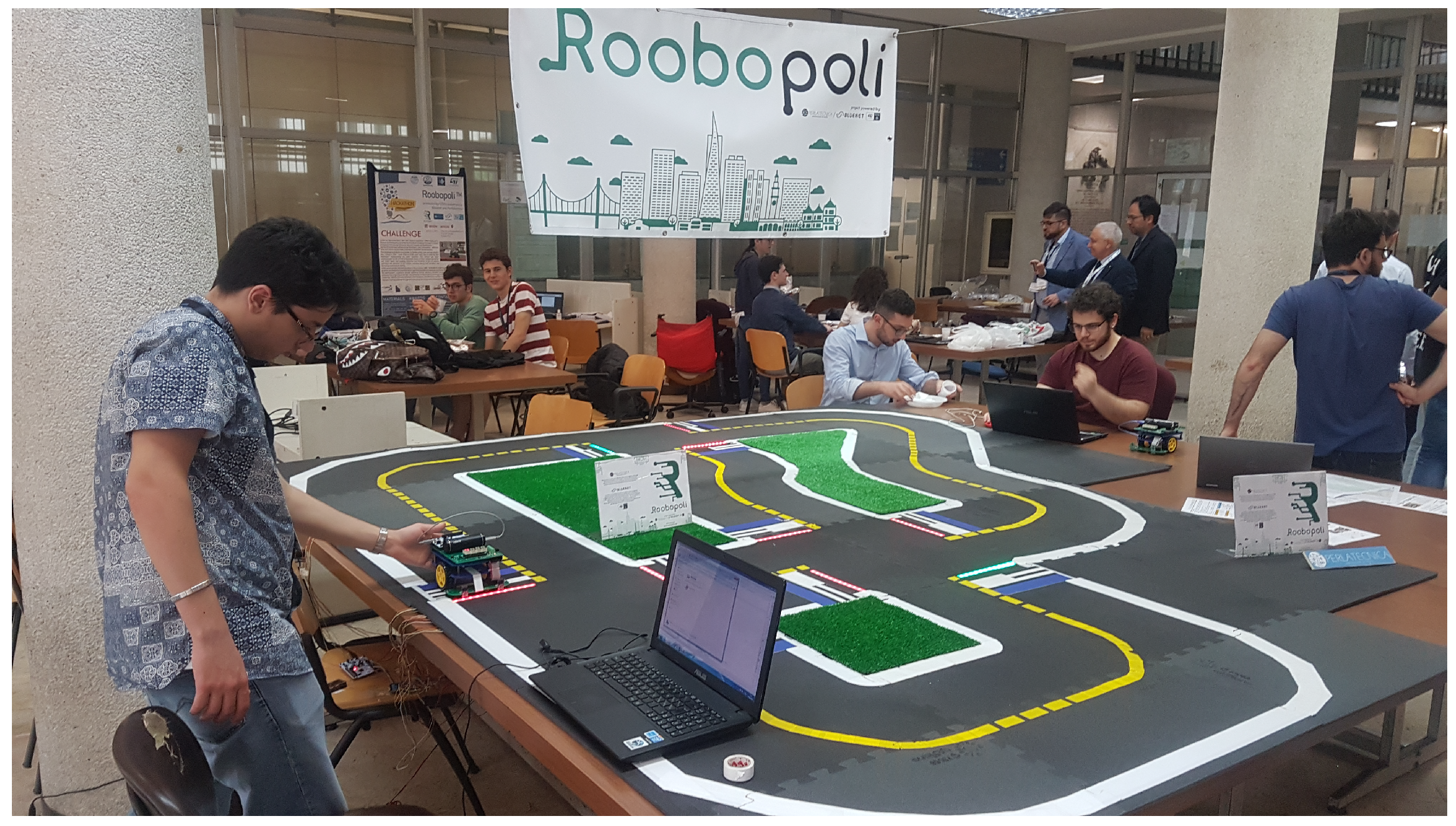
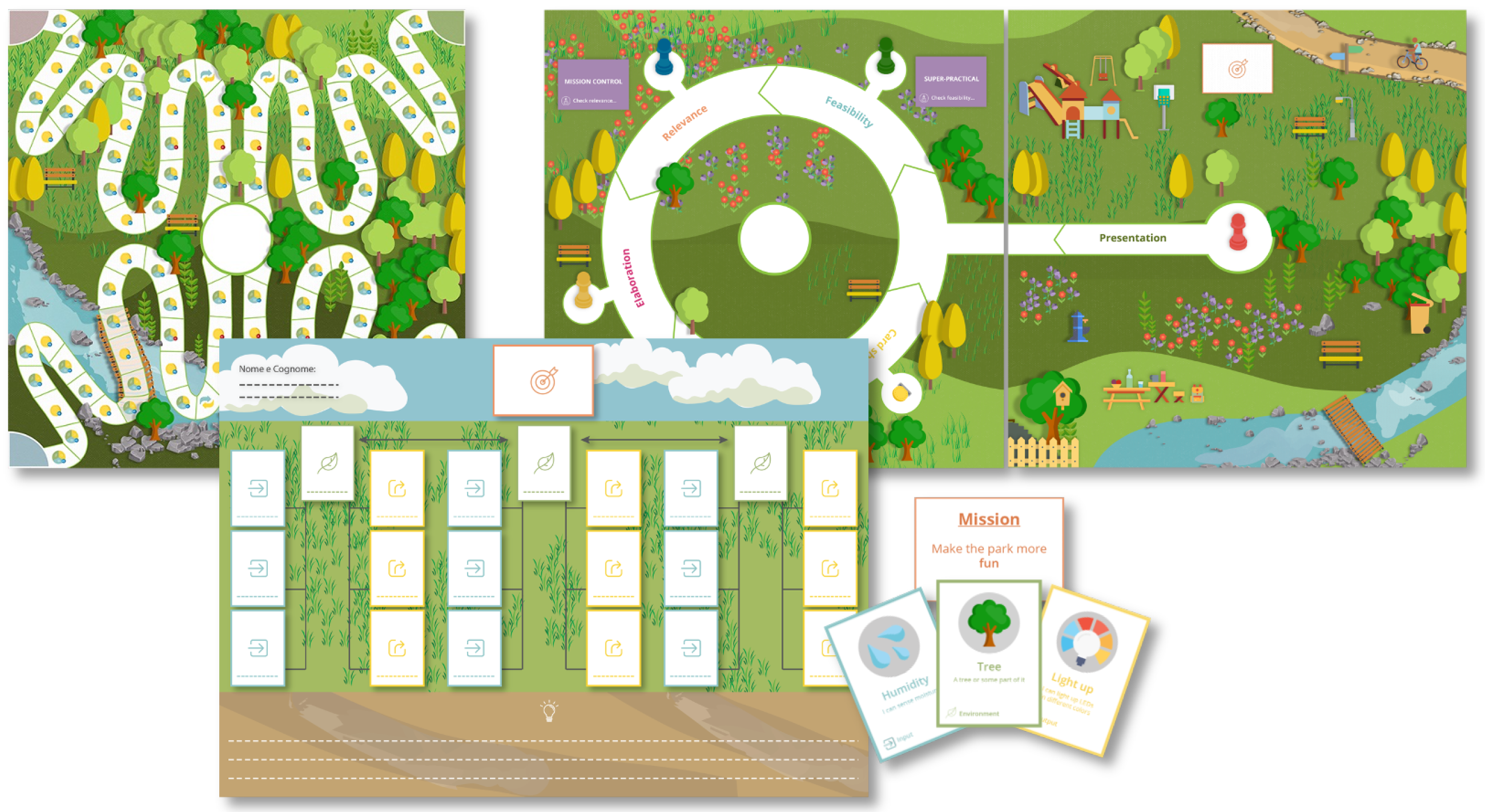

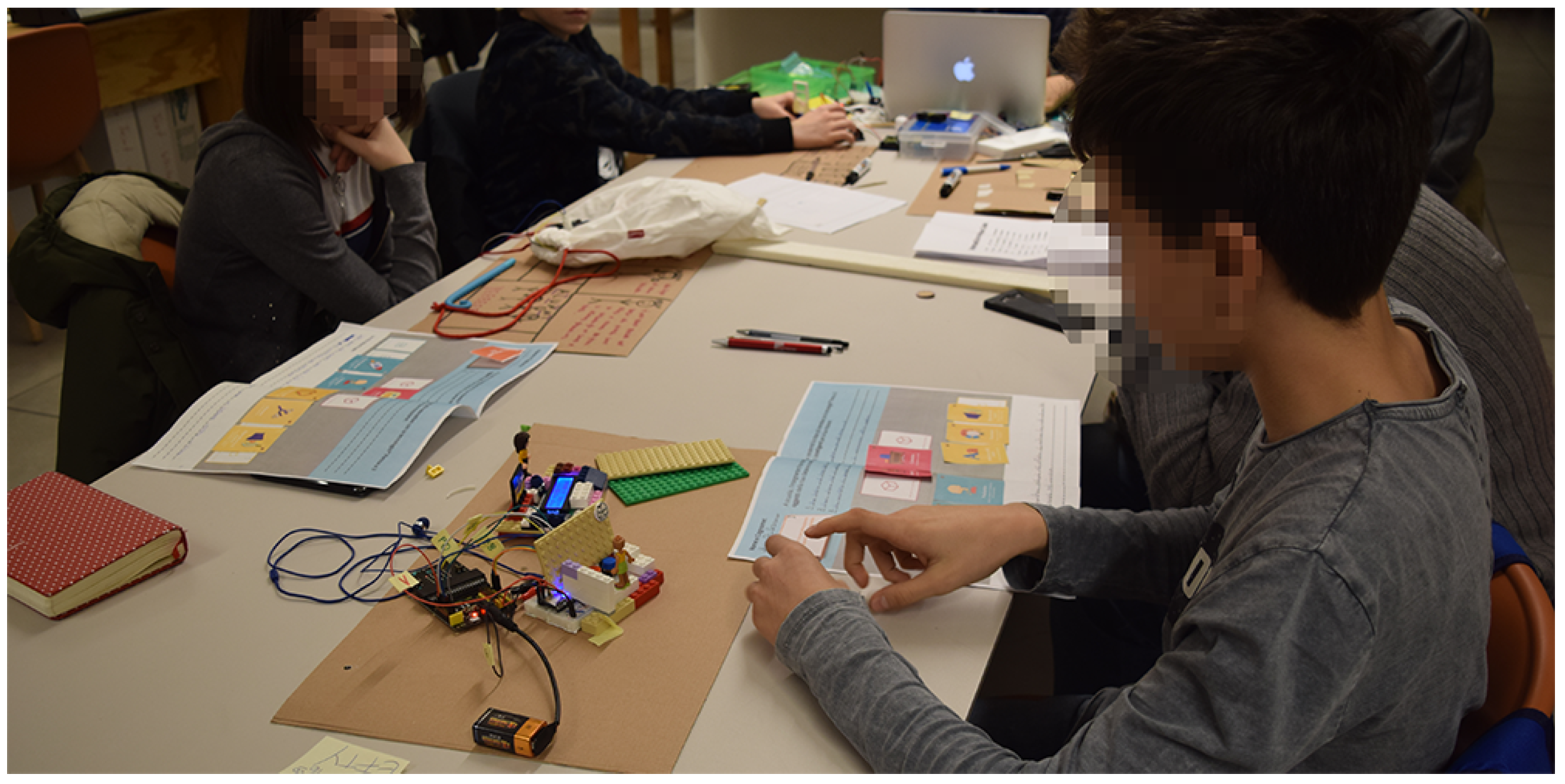
| Study | Stages | Materials | Setting | Modality | Duration | Children | Age | Females |
|---|---|---|---|---|---|---|---|---|
| [8] | (1) familiarization (2) city model (3) problem resolution | paper-based
city model | formal | in presence | hours | 21 | 12–14 | 40% |
| [2] | (1) familiarization (2) city model (3) problem resolution | interactive table | formal | in presence | hours | - | 12–14 | - |
| [21] | (1) brainstorming (2) idea exploration (3) programming (4) reflection | Scratch, MBlock, DOC MBot | formal | in presence | months | 346 | 6–9 | - |
| [33] | (1) familiarization (2) ideation (3) programming | virtual reality | informal | in presence | hours | 30 | 6–10 | 60% |
| [34] | (1) exploration (2) programming | augmented reality, conversation agent | - | - | - | - | 7–12 | - |
| [35] | (1) programming | NetsBlox, Unity game | - | at a distance | - | - | - | - |
| [36] | (1) programming | Micro:bit | - | - | - | - | - | - |
| [37] | (1) exploration (2) algorithmic (3) programming | Roobokart | formal | in presence | days | 300 | 13–18 | 30% |
| [37] | (1) exploration (2) algorithmic (3) programming | mBot | informal | in presence | hours | 60 | 10–13 | 25% |
| Study | Stages | Materials | Setting | Modality | Duration | Children | Age | Females |
|---|---|---|---|---|---|---|---|---|
| [38] | (1) imagine & discover (2) make & prototype (3) test & present (4) reflect | physical computing devices, crafting material | formal | in presence | hours | >100 | 10–14 | - |
| [39] | (1) design brief (2) field studies (3) ideation (4) fabrication (5) reflection | physical computing devices, 3d printers, crafting material | formal | in presence | weeks | >69 | 11–15 | - |
| [40,41] | (1) ideation (2) conceptualisation (3) prototyping (4) refining & testing (5) evaluation | physical computing devices, crafting material | informal | in presence | months | 5 | 6–8 | 20% |
| [42] | (1) storytelling (2) idea generation (3) mock-up creation (4) reflections | 3d printers, paper-based material | informal | in presence | weeks | 24 | 7–8 | - |
| [43] | (1) exploration (2) programming | physical computing devices | informal | in presence | days | 6 | 11–12 | 100% |
| [44] | (1) planning (2) scaffolding (3) building inquiry skills (4) teacher-child & peer-peer interactions (5) assessment/review | physical computing devices | formal | in presence | weeks | 17 | 4–5 | - |
| [45] | (1) exploration (2) ideation & programming | Tiles ideation toolkit, RapIoT, physical computing devices | formal | in presence | hours | 44 | 14–17 | - |
| [46] | (1) exploration (2) ideation | Tiles ideation toolkit | formal | in presence | hours | 17 | 14–15 | 12% |
| [47] | (1) introduction (2) ideation (3) programming & prototyping | adapted Tiles cards, physical computing devices | informal | in presence | hours | 21 | 10–11 | 52% |
|
[48,49] [50,51] |
(1) exploration (2) ideation (3) programming & prototyping |
physical SNaP toolkit, physical computing devices | informal | in presence | days, weeks | 27 | 11–14 | 37% |
| [52,53] |
(1) exploration (2) ideation (3) programming & simulation | digital SNaP toolkit | informal | at a distance | days | 20 | 8–16 | 40% |
Publisher’s Note: MDPI stays neutral with regard to jurisdictional claims in published maps and institutional affiliations. |
© 2022 by the authors. Licensee MDPI, Basel, Switzerland. This article is an open access article distributed under the terms and conditions of the Creative Commons Attribution (CC BY) license (https://creativecommons.org/licenses/by/4.0/).
Share and Cite
Pellegrino, M.A.; Roumelioti, E.; D’Angelo, M.; Gennari, R. Children’s Participation in the Design of Smart Solutions: A Literature Review. Smart Cities 2022, 5, 475-495. https://doi.org/10.3390/smartcities5020026
Pellegrino MA, Roumelioti E, D’Angelo M, Gennari R. Children’s Participation in the Design of Smart Solutions: A Literature Review. Smart Cities. 2022; 5(2):475-495. https://doi.org/10.3390/smartcities5020026
Chicago/Turabian StylePellegrino, Maria Angela, Eftychia Roumelioti, Mauro D’Angelo, and Rosella Gennari. 2022. "Children’s Participation in the Design of Smart Solutions: A Literature Review" Smart Cities 5, no. 2: 475-495. https://doi.org/10.3390/smartcities5020026
APA StylePellegrino, M. A., Roumelioti, E., D’Angelo, M., & Gennari, R. (2022). Children’s Participation in the Design of Smart Solutions: A Literature Review. Smart Cities, 5(2), 475-495. https://doi.org/10.3390/smartcities5020026






